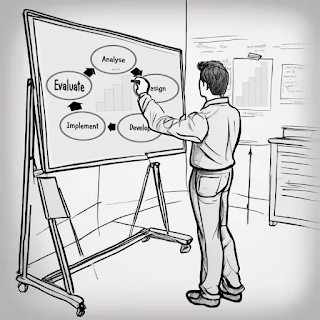ADDIE: The Evaluation Stage
Continuous Feedback through Formative Assessment:
Imagine you're driving a car. You point it where you want to go but every few seconds, or even more frequently, you check your direction to ensure you're still going in the right direction and you're not going to crash. Evaluation in ADDIE functions similarly. We use formative assessments throughout the process to gather ongoing feedback and make adjustments as needed. This might involve:
PWL, a leading retail corporation, applies formative assessment techniques during the development and implementation of its customer service training program. By pilot testing the training program with a small group of employees, PWL can identify any issues with content, delivery, or learner comprehension early on. Gathering feedback from instructors and learners during the initial implementation stage allows PWL to make immediate adjustments based on real-time insights. Additionally, monitoring learner progress through quizzes or assignments on the Virtual Training Centre (VTC) platform enables PWL to gauge understanding and address any gaps in knowledge or skill development promptly.
Measuring Success with Diverse Evaluation Methods:
Just like there's no single "best" delivery method in ADDIE, there's no one-size-fits-all approach to evaluation. Educatorshave a variety of tools at their disposal to assess the effectiveness of the learning experience:
- Surveys: Gather feedback from learners on their experience, content clarity, and overall satisfaction through surveys administered via the VTC platform. PWL can customise survey questions to target specific aspects of the training program, such as the relevance of content to job roles or the effectiveness of training materials.
- Quizzes and Exams: Formal assessments like quizzes and exams measure knowledge acquisition and skill development. PWL can leverage the features of the VTC platform to administer quizzes and other assessments, tracking learner progress and performance in real-time.
Another thing we have to remember is that we're not just measuring improvements in our learning participants. More importantly, we need to measure our progress towards the organisational goals or objectives discovered during the analysis stage. In most cases, tracking performance metrics after the training can provide valuable insights into its real-world impact. PWL can monitor key performance indicators (KPIs) such as customer satisfaction scores, employee productivity metrics, or sales performance to assess the tangible outcomes of the training program.
The Evaluation Cycle: A Never-Ending Journey
The beauty of the ADDIE process is its cyclical nature. The information gathered through evaluation feeds back into the beginning stages of the next iteration of the cycle, allowing for continuous improvement. Educators can use the evaluation data to refine the learning objectives, update content, or adjust delivery methods for future iterations of the program.
Evaluation ensures the training program remains relevant, effective, and meets the ever-evolving needs of the learners. It's the final piece of the puzzle, transforming the ADDIE process from a linear model to a dynamic cycle of incremental learning and improvement.



